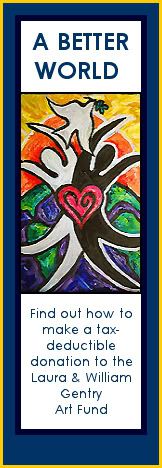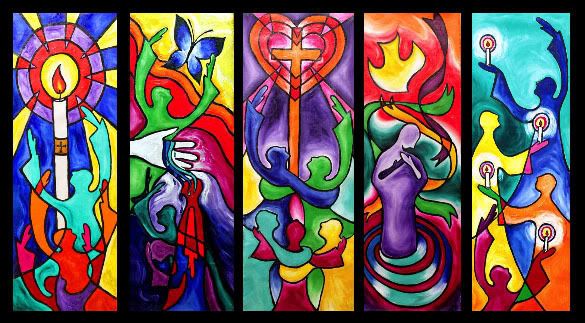A Sermon for the Thanksgiving Eve
November 25, 2009
Pastor Laura Gentry
Luke 17:11-19
Like the Samaritan in tonight’s reading, we can recognize how completely dependent upon God we are. And like him, we can praise God in a loud voice and throw ourselves at God’s feet, recognizing that what we have is not our entitlement. It is a gift. All is gift.
It’s one thing to know this and it’s another to really live as grateful people. But it is important that we find a way to do so, for as the Roman philosopher Marcus Cicero said: "gratitude is not only the greatest of virtues, but the parent of all the others." Elie Wiesel, an award-winning author who survived the Holocaust, said, “when a person doesn’t have gratitude, something is missing in his or her humanity. A person can almost be defined by his or her attitude toward gratitude.”
We are not fully alive if we are not fully grateful. So how can we get grateful? Perhaps you’re not the perky-cheery type—you don’t naturally see the cup as half full and so it’s more difficult to be appreciative. That’s okay because even YOU can learn. Like any other skill, gratitude can be learned. Thus, on Thanksgiving eve, I offer you 7 ways to be thankful. There are countless ways to be thankful, but these are my favorites.
1. Decide to be Thankful
Sounds so easy, doesn’t it? But our intention is very powerful. Just by deciding that you want to be thankful, you’re already well on your way. Better yet, put it in writing. Write: “I want to be thankful” and hang it up where you’ll see it often. This will help motivate you to develop your thankfulness.
2. Say Thanks
You probably already thank people when they do nice things for you but you may still be missing opportunities to say thank you. Whenever anyone does anything for you—big or small—jump at the chance to thank them. And do it with a smile. It makes them feel good and makes you feel good too.
Dan Baker, Ph.D., writes in What Happy People Know: "Just as changing your life can change your language, changing your language can change your life." Most people run themselves down a lot. Do you realize we have about 10,000 conversations with ourselves every day? So what we say to ourselves really matters. When we say thank you to ourselves instead of heaping up condemnation, we can change our lives for the better. Then it is even easier for us to speak thankfulness to others.
3. Start a Thanksgiving Journal
You’ve heard me push this point before but that’s because it really works. In research done by Robert Emmons and Michael McCullough, those who kept a daily journal expressing their thanks experienced higher levels of emotional and physical well-being.This research also proved that keeping such a journal can improve your health: raise energy levels, promote alertness and determination, improve sleep, and possibly relieve pain and fatigue. If there were a free pill available that promised all these things, you’d probably want to to take it, wouldn’t you? Then why not try this simple exercise? It is just a structured way to count your blessings.
Here’s how it works: Get a notebook. At the end of each day, reflect back upon the day’s events and write down five things for which you feel grateful. They can be anything big or small: a nice conversation with someone, an important task accomplished, the beautiful weather. It doesn’t matter what you write, just do it—every day. Five things and as you write them down, think about them and bring to mind the positive emotions associated with those things or events. It generally takes less than 5 minutes to do this and in just 30 days, you will have formed a new habit, thus cultivating a stronger sense of thankfulness.
4. Connect with Thankful People
People who achieve great things always have coaches pushing them to do their best. This same principle works with thankfulness. It’s all to easy to get grumpy, lose our gratefulness and fall into negative patterns when we are trying to go it alone. That’s why we gather together for worship as a congregation: we need to help one another. Find people who can help you see that things are a lot sunnier than they might seem. They are your thankfulness coaches and you are theirs. It’s exciting that you can provide mutual encouragement and urge each other to be your most thankful selves.
5. Write a thank you letter
A great exercise suggested by Dr. Emmons, known as "the father of gratitude," is to compose a thank you letter to a person who has made a positive and lasting influence in your life. Emmons says the letter is especially powerful when you have not properly thanked the person in the past, and when you read the letter aloud to the person face to face.
6. Pray
This quote is attributed to Meister Eckhart: "If the only prayer you say in your life is 'thank you,' that would suffice.” Thankfulness and prayer go hand in hand. Take time daily—perhaps even regularly throughout the day—to pray in thankgiving to God. You can throw up “bullet prayers” that are quick and to the point thanking God for things as they happen. You can also try doing a breath prayer in the quietness of your meditation time where you simply breathe in and out while saying “thank you” in your mind.
7. Give
An important way to cultivate thankfulness is to give out of our abundance to help others. This could be spending time helping people, sharing your talents and gifts as well as giving money to charitable causes. There is joy giving. As we heard in the reading from 2 Corinthians tonight, God loves a cheerful giver. Generosity opens our hearts and allows even more blessings to flow into our lives.
This Thanksgiving, I’m here to tell you, we cannot afford to miss being thankful. Our hearts need gratitude—it is good for what ails us. Jesus knew this, the Samaritan leper knew this, the Pilgrims knew this and scientists know this. The question is do we want to miss out like the nine lepers or do we want to praise God with a loud voice and know that joy of being thankful for the grace bestowed upon us? It is my prayer that these 7 ways to be more grateful will help put you on the thankfulness track so you can cultivate a deeper attitude of gratitude that will transform you and those around you—not just this Thanksgiving, but always. Amen.
And now, may the peace which passes all understanding keep our hearts and our minds in Christ Jesus our Lord. Amen.
© 2009 Laura E. Gentry







